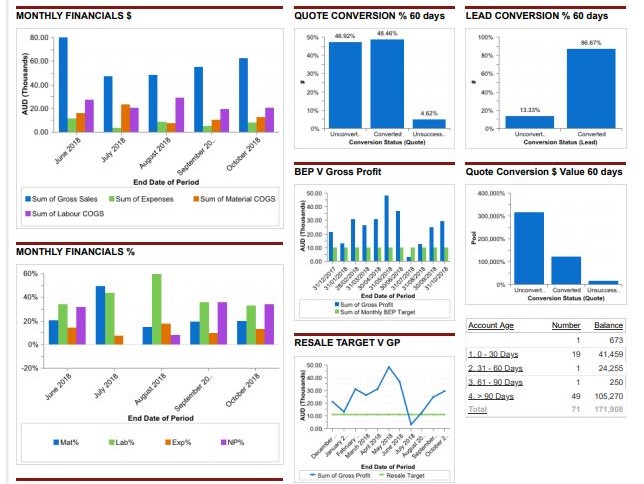
Data is essential to help franchisees improve their businesses. The challenge for franchisors is to decide the quantity of data that needs to be available, and the best way to deliver it.
So what should be included in a first class digital dashboard?
Brendan Green, CEO of Hire A Hubby, and the founder of Franchise Cloud Solutions, believes the dashboard should be just a single page.
“Have only the relevant data that either the franchisee needs to see or the field support manager needs to see,” he suggests.
“For HAH, if I know how much money a franchisee needs to earn, and I know their Lead To Quote, and Quote To Invoice conversion rates, average GP per sale, then we can calculate quickly if they’re on target.
“For me the dashboard will often highlight that the franchisee has enough leads to hit their target, but often it’s their methods that are failing them.
“If they have a cash flow issue or lack of upcoming work, the dashboard will highlight if they have a significant number of quotes that may not have been followed up.”
Green adds “All of this can resonate on a smart phone if our field team are trying to help.”
Integrating data with other methods of business information and support is crucial to better business. There has been a greater emphasis on franchisees focusing on their personal goals, and having those goals drive the business goals, says Green. “This has added a significant purpose to how they go about their business. Each franchisee is encouraged to come to a quarterly support group meeting whereby they review the last quarter activities, assess how they’ve gone against their nominated improvement opportunities.
“With a monthly personal review to support the quarterly group structure, we seem to have found a sweet spot for franchisees spending enough time working on the business as well as in the business.”
Case study: building a dashboard
Keeping it simple and user-friendly is crucial for a dashboard to have impact and become part of a franchisee’s daily life.
The development of the right tools has been a work in progress for Nik Leigh, CEO at Real Property.
“It had long been a goal of ours to develop our very own software that would aid in two key areas – operational efficiency and individual unit data,” he says.
“As franchisees are also business owners, we wanted to provide a tool that would give access to data insights allowing them to make more informed decisions for their business, sooner, leading to greater satisfaction and profitability.”
In late 2017 work began on designing proprietary software for both a web app and a mobile app.
“Initial design or UI/ UX is one of the most important aspects for any digital project, and regrettably was one of the areas that we experienced the most troubles with for our recently deployed web-app.
“Having this designed by an experienced designer who will take the time to understand how a franchisee would use your software is vital and is initially where we had some challenges. Creating an initial prototype through the UI/ UX stage will also allow you to gather some vital feedback from those users who matter the most – the franchisee. This will also prevent you from making any costly mistakes during development and introducing features that will be under-utilised or not valued. “
Leigh believes a superior franchisee dashboard needs to be seen to be more than “data visualisation” while keeping the spotlight on the core operations of the franchisee.
“It needs to seamlessly integrate and automate mindless tasks,” he suggests. “Prior to the build of our dashboard, we relied on franchisees to send through their monthly reporting requirements including sales data, however by integrating XERO through an API, I am now able to see sales data/ history all in real time through my own personalised franchisor dashboard meaning less reporting requirements for franchisees.”
A further step was to integrate a dashboard for suppliers and bridge the communication gap between these two parties. The resulting reduction in inefficiencies and head office team overload has led to significant improvements in workflow.
After an initial hiccup at launch when the dashboard was down for almost 24 hours, the first eight weeks was used as a feedback period.
“We listened closely to the feedback of our users, even releasing a survey asking for their “feature wish-lists” and compiled this into a vote type system that would see the most favoured features be implemented first.
“We are well on track to implementing these along with working on our mobile application (iOS & Android) that will be rolled out in 2019,” says Leigh.
“My advice to franchisors who are looking at adopting digital tools into their business is to think proprietary. Whilst choosing an off-the-shelf product may be a good idea now, you may find it become redundant as your need for a more customised approach will be inevitable. “
And there’s another reason Leigh believes an own-brand platform has benefits for franchisors.
“By building something customised to your system you are also showcasing to prospective franchisees your ability to adapt to future trends ensuring that your franchisees are equipped with what they require to run their business today and tomorrow.”

